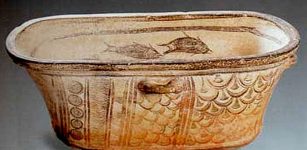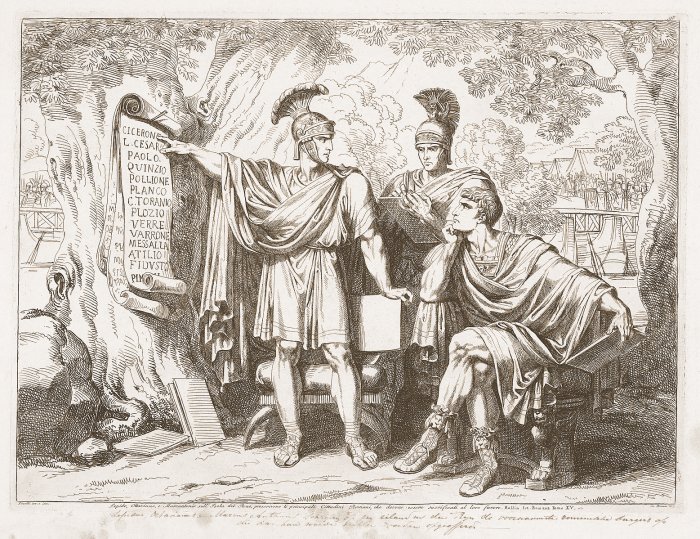Triumvirates In Ancient Rome: Power Struggle, Intrigue And Ambush
Conny Waters - AncientPages.com - A triumvirate (in Latin' tre viri' - three-man - or 'triumviri') was a board of three officials who shared a position of authority or power in ancient Rome.
Lepidus, Octavian and Mark Antony make a list of names of the most important Romans, whom they can execute with impunity and expropriate their property (the second triumvirate). Image credit: Rijksmuseum -Credit line: Schenking van J.J. de Man, Ede - CC0 1.0 DEED
A political agreement between these statesmen enabled them to govern together so that "nothing in the republic could happen without their consent."
The "First Triumvirate," also known as - the alliance of 'three' - was an unofficial arrangement made in 60 BC by Gnaeus Pompeius Magnus (Pompey' the Great'), Gaius Julius Caesar, and Marcus Licinius Crassus.
These three strong political leaders could control the Roman political system and support each other to achieve their goals.
This "first alliance of three" lasted until the death of Crassus, who started an unwarranted invasion of Parthia and was killed in 53 BC during the Battle of Carrhae (now Harran Southeastern Anatolia, Turkey.
Caesar's triumphant military campaigns in Gaul and Pompey's persistent pursuit of more alliances to weaken Caesar unintentionally paved the way for a conflict. Pompey was defeated at the Battle of Pharsalus in 48 BC and sought refuge in Ptolemaic Egypt, where the courtiers of Ptolemy XIII assassinated him. The triumvirate fell apart because of a battle and ambush. Caesar ruled alone until his assassination in the Senate in 44.
The Second triumvirate was created in 43 BC by a Roman law, 'lex Titia.'
It granted Mark Antony, the young Caesar (the future Augustus), and Lepidus unlimited power for five years.
The triumvirate was later renewed in 38 BC. Unlike the so-called First Triumvirate, a private arrangement among three men, the Second Triumvirate was a legal instrument that created a formal legal framework to empower the three triumvirs with practically absolute power.
They had the authority to enact or abolish laws and issue judicial penalties without following due process or allowing for appeals, and they were responsible for appointing all other officials.
Additionally, they divided the Roman world into three distinct provinces.
This agreement concluded in 43 BC between Octavian, Marek Antony, and Marek Lepidus, was established to sort out the situation in Rome after the death of Gaius Julius Caesar and punish his assassins.
The Augustus of Prima Porta, 1st century AD, depicting Augustus, the first Roman emperor. Image credit: Joel Bellviure - CC BY-SA 4.0
The Second triumvirate differed from the first in that it was a legal entity expressly approved by the Senate rather than a private contract between strongmen. However, the second suffered the same fate as the first.
Many internal quarrels and jealousy led to its weakening and downfall.
Lepidus was the first to fall. After a power struggle against Octavian, he was stripped of all his offices except Pontifex Maximus in the year 36 and later banished to a remote island. Antony, on the other hand, spent four decades in Egypt living with Cleopatra and progressively distancing himself from Rome's political power plays. He met a crushing defeat at the 31st Battle of Actium.
It was a devastating loss, and Antony took his own life.
Octavian changed his title to Augustus in 27 AD and became the first emperor of Rome. The situation in ancient Rome began to change; the power of the Senate and its consuls was broken. The Roman Empire began its almost half-millennium influence on the Mediterranean world.
Among several different triumvirates, there was, for example, 'tresviri monetales 'in charge of the mint for Rome and Italy during the republic and the empire.
Another one, 'Tresviri epulones,' was initially a board of three priests created in 196 BC to manage the banquet of Jupiter, the critical event in the Ludi Romani and Ludi Plebeii festivals.
Written by Conny Waters - AncientPages.com Staff Writer
Copyright © AncientPages.com All rights reserved. This material may not be published, broadcast, rewritten or redistributed in whole or part without the express written permission of AncientPages.com
Expand for referencesReferences:
Clifford A. The First Triumvirate Of Rome
Zoch Paul. A. Ancient Rome: An Introductory History
Balsamo W. The First Triumvirate Of Rome
More From Ancient Pages
-
 Huge Subterranean Pre-Columbian Shaft Tombs In Tierradentro, Colombia
Featured Stories | Apr 28, 2021
Huge Subterranean Pre-Columbian Shaft Tombs In Tierradentro, Colombia
Featured Stories | Apr 28, 2021 -
 Mysterious Grave Of King Valdemar IV Atterdag – Will The 600-Year-Old Historical Puzzle Ever Be Solved?
Featured Stories | Jul 14, 2018
Mysterious Grave Of King Valdemar IV Atterdag – Will The 600-Year-Old Historical Puzzle Ever Be Solved?
Featured Stories | Jul 14, 2018 -
 Rare 17th Century Wreck Of Dutch Fluit Ship Found In The Baltic Sea By Finnish Divers
News | Aug 25, 2020
Rare 17th Century Wreck Of Dutch Fluit Ship Found In The Baltic Sea By Finnish Divers
News | Aug 25, 2020 -
 Paris Point Zero And The Mysterious Statue Of Monsieur Legris
Featured Stories | Dec 4, 2018
Paris Point Zero And The Mysterious Statue Of Monsieur Legris
Featured Stories | Dec 4, 2018 -
 Ancient Secrets Of The Black Basalt Statue Of Priest Djedhor Revealed
Artifacts | Feb 26, 2021
Ancient Secrets Of The Black Basalt Statue Of Priest Djedhor Revealed
Artifacts | Feb 26, 2021 -
 European Bronze Age Treasure Of Villenna Has Artifacts Made Of Meteoric Iron
Archaeology | Feb 12, 2024
European Bronze Age Treasure Of Villenna Has Artifacts Made Of Meteoric Iron
Archaeology | Feb 12, 2024 -
 Roman-Era Girl Buried And Adorned With 1,700-Year Old Gold Jewelry Found In Pagan Cave
Archaeology | Apr 8, 2023
Roman-Era Girl Buried And Adorned With 1,700-Year Old Gold Jewelry Found In Pagan Cave
Archaeology | Apr 8, 2023 -
 Llyn Y Dywarchen – Enigmatic Lake Shrouded In Myth And Legend
Featured Stories | Jun 29, 2021
Llyn Y Dywarchen – Enigmatic Lake Shrouded In Myth And Legend
Featured Stories | Jun 29, 2021 -
 Medieval Rich People Unknowingly Poisoned Themselves With Lead And Other Hazardous Heavy Metals
Archaeology | Nov 29, 2015
Medieval Rich People Unknowingly Poisoned Themselves With Lead And Other Hazardous Heavy Metals
Archaeology | Nov 29, 2015 -
 A Rare 1,500 Year Old Mosaic That Depicts Ancient Streets And Buildings in Egypt – Discovered
News | Sep 29, 2015
A Rare 1,500 Year Old Mosaic That Depicts Ancient Streets And Buildings in Egypt – Discovered
News | Sep 29, 2015 -
 Likho (Licho): Puzzling And Persistent Demon Of Mischief In Slavic Mythology
Featured Stories | Dec 18, 2016
Likho (Licho): Puzzling And Persistent Demon Of Mischief In Slavic Mythology
Featured Stories | Dec 18, 2016 -
 Was Hygiene Important For Our Ancestors?
Featured Stories | Feb 11, 2017
Was Hygiene Important For Our Ancestors?
Featured Stories | Feb 11, 2017 -
 Enigma Of The Missing Pyramid Bodies – Ancient Egyptian Mystery Remains Unsolved
Civilizations | Dec 10, 2018
Enigma Of The Missing Pyramid Bodies – Ancient Egyptian Mystery Remains Unsolved
Civilizations | Dec 10, 2018 -
 Rare Ancient Human Footprints Found On Gower Peninsula, Wales Are 7,000 Years Old
Archaeology | Mar 8, 2017
Rare Ancient Human Footprints Found On Gower Peninsula, Wales Are 7,000 Years Old
Archaeology | Mar 8, 2017 -
 Are The Mysterious ‘Ubeidiya Limestone Spheroids Of Early Hominins Evidence Of Intentional Symmetric Geometry?
Archaeology | Sep 6, 2023
Are The Mysterious ‘Ubeidiya Limestone Spheroids Of Early Hominins Evidence Of Intentional Symmetric Geometry?
Archaeology | Sep 6, 2023 -
 8,000-Year-Old Yarmukian ‘Mother Goddess’ Figurine Discovered In Israel
Archaeology | Jul 18, 2022
8,000-Year-Old Yarmukian ‘Mother Goddess’ Figurine Discovered In Israel
Archaeology | Jul 18, 2022 -
 Mystery Of The Wizard Clip – Unexplained Half-Moon Clippings And Supernatural Phenomena West Virginia
Featured Stories | Dec 14, 2020
Mystery Of The Wizard Clip – Unexplained Half-Moon Clippings And Supernatural Phenomena West Virginia
Featured Stories | Dec 14, 2020 -
 An Expert Explains Why Tutankhamun’s Tomb Remains One Of The Greatest Archaeological Discoveries
Archaeology | Nov 2, 2022
An Expert Explains Why Tutankhamun’s Tomb Remains One Of The Greatest Archaeological Discoveries
Archaeology | Nov 2, 2022 -
 New Fossil Link In Bird Evolution Discovered
Evolution | Sep 7, 2023
New Fossil Link In Bird Evolution Discovered
Evolution | Sep 7, 2023 -
 Cosmic Impact 12,800 Years Ago Forced Hunter-Gatherers In The Levant To Adopt Agricultural Practices
Archaeology | Oct 4, 2023
Cosmic Impact 12,800 Years Ago Forced Hunter-Gatherers In The Levant To Adopt Agricultural Practices
Archaeology | Oct 4, 2023



